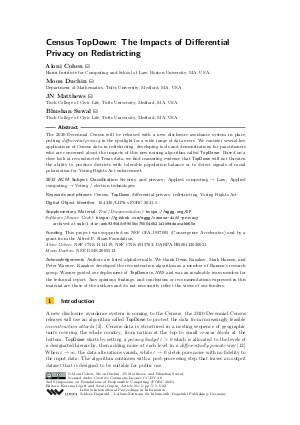Census TopDown: The Impacts of Differential Privacy on Redistricting
Authors Aloni Cohen, Moon Duchin, JN Matthews, Bhushan Suwal
-
Part of:
Volume:
2nd Symposium on Foundations of Responsible Computing (FORC 2021)
Part of: Series: Leibniz International Proceedings in Informatics (LIPIcs)
Part of: Conference: Symposium on Foundations of Responsible Computing (FORC) - License:
 Creative Commons Attribution 4.0 International license
Creative Commons Attribution 4.0 International license
- Publication Date: 2021-05-31
File

PDF
LIPIcs.FORC.2021.5.pdf
- Filesize: 4.96 MB
- 22 pages
Document Identifiers
Subject Classification
ACM Subject Classification
- Security and privacy
- Applied computing → Law
- Applied computing → Voting / election technologies
Keywords
- Census
- TopDown
- differential privacy
- redistricting
- Voting Rights Act
Metrics
- Access Statistics
-
Total Accesses (updated on a weekly basis)
0Document
0Metadata
Abstract
The 2020 Decennial Census will be released with a new disclosure avoidance system in place, putting differential privacy in the spotlight for a wide range of data users. We consider several key applications of Census data in redistricting, developing tools and demonstrations for practitioners who are concerned about the impacts of this new noising algorithm called TopDown. Based on a close look at reconstructed Texas data, we find reassuring evidence that TopDown will not threaten the ability to produce districts with tolerable population balance or to detect signals of racial polarization for Voting Rights Act enforcement.
Cite As Get BibTex
Aloni Cohen, Moon Duchin, JN Matthews, and Bhushan Suwal. Census TopDown: The Impacts of Differential Privacy on Redistricting. In 2nd Symposium on Foundations of Responsible Computing (FORC 2021). Leibniz International Proceedings in Informatics (LIPIcs), Volume 192, pp. 5:1-5:22, Schloss Dagstuhl – Leibniz-Zentrum für Informatik (2021)
https://doi.org/10.4230/LIPIcs.FORC.2021.5
BibTex
@InProceedings{cohen_et_al:LIPIcs.FORC.2021.5,
author = {Cohen, Aloni and Duchin, Moon and Matthews, JN and Suwal, Bhushan},
title = {{Census TopDown: The Impacts of Differential Privacy on Redistricting}},
booktitle = {2nd Symposium on Foundations of Responsible Computing (FORC 2021)},
pages = {5:1--5:22},
series = {Leibniz International Proceedings in Informatics (LIPIcs)},
ISBN = {978-3-95977-187-0},
ISSN = {1868-8969},
year = {2021},
volume = {192},
editor = {Ligett, Katrina and Gupta, Swati},
publisher = {Schloss Dagstuhl -- Leibniz-Zentrum f{\"u}r Informatik},
address = {Dagstuhl, Germany},
URL = {https://drops.dagstuhl.de/entities/document/10.4230/LIPIcs.FORC.2021.5},
URN = {urn:nbn:de:0030-drops-138736},
doi = {10.4230/LIPIcs.FORC.2021.5},
annote = {Keywords: Census, TopDown, differential privacy, redistricting, Voting Rights Act}
}
Author Details
Funding
This project was supported on NSF OIA-1937095 (Convergence Accelerator) and by a grant from the Alfred P. Sloan Foundation.
- Cohen, Aloni: NSF CNS-1414119; NSF CNS-1915763; DARPA HR00112020021.
- Duchin, Moon: NSF DMS-2005512
Acknowledgements
Authors are listed alphabetically. We thank Denis Kazakov, Mark Hansen, and Peter Wayner. Kazakov developed the reconstruction algorithm as a member of Hansen’s research group. Wayner guided our deployment of TopDown in AWS and was an invaluable team member for the technical report. Any opinions, findings, and conclusions or recommendations expressed in this material are those of the authors and do not necessarily reflect the views of our funders.
Supplementary Materials
- Text (Documentation) https://mggg.org/DP
-
Software (Source Code)
https://github.com/mggg/census-diff-privacy
browse
 archived version
archived version
References
- 13 U.S.C. Section 9. URL: https://www.law.cornell.edu/uscode/text/13/9.
- John Abowd, Daniel Kifer, Brett Moran, Robert Ashmead, Philip Leclerc, William Sexton, Simson Garfinkel, and Ashwin Machanavajjhala. Census topdown: Differentially private data, incremental schemas, and consistency with public knowledge, 2019. URL: https://github.com/uscensusbureau/census2020-dase2e/blob/master/doc/20190711_0945_Consistency_for_Large_Scale_Differentially_Private_Histograms.pdf.
-
Avery v. Midland County, 390 U.S. 474 (1968).

- U.S. Census Bureau. Disclosure avoidance system - End to End demonstration. URL: https://github.com/uscensusbureau/census2020-das-e2e.
- U.S. Census Bureau. Disclosure avoidance system - End to End demonstration, L1 metric. URL: https://github.com/uscensusbureau/census2020-das-e2e/blob/3f2c9cf9cb3c33a4e2067bd784ff381792f7ffc0/programs/validator.py#L20.
- U.S. Census Bureau. TopDown: Adding Geometric Noise to Counts. URL: https://github.com/uscensusbureau/census2020-das-e2e/blob/d9faabf3de987b890a5079b914f5aba597215b14/programs/engine/topdown_engine.py#L678.
- U.S. Census Bureau. 2010 Demonstration Data Products, 2010. URL: https://www.census.gov/programs-surveys/decennial-census/2020-census/planning-management/2020-census-data-products/2010-demonstration-data-products.html.
- U.S. Census Bureau. 2010 Census Summary File 1, 2012. URL: https://www.census.gov/prod/cen2010/doc/sf1.pdf.
- U.S. Census Bureau. Census P.L. 94-171 Redistricting Data, 2017. URL: https://www.census.gov/programs-surveys/decennial-census/about/rdo/summary-files.html.
-
Daryl DeFord, Moon Duchin, and Justin Solomon. Recombination: A family of markov chains for redistricting. arXiv preprint arXiv:1911.05725, 2019.

-
Irit Dinur and Kobbi Nissim. Revealing information while preserving privacy. In Proceedings of the twenty-second ACM SIGMOD-SIGACT-SIGART symposium on Principles of database systems, pages 202-210, 2003.

-
Cynthia Dwork, Frank McSherry, Kobbi Nissim, and Adam Smith. Calibrating noise to sensitivity in private data analysis. Halevi S., Rabin T. (eds) Theory of Cryptography. TCC 2006. Lecture Notes in Computer Science, 3876, 2006.

- Peter Wayner JN Matthews, Bhushan Suwal. Accompanying GitHub repository. URL: https://github.com/mggg/census-diff-privacy.
- Denis Kazakov. Census Scripts GitHub repository, 2019. URL: https://github.com/94kazakov/census_scripts.
- U.S. Census Bureau Michael Hawes. Differential Privacy and the 2020 Decennial Census, 2020. URL: https://www2.census.gov/about/policies/2020-03-05-differential-privacy.pdf.
- National Conference of State Legislatures. 2010 Redistricting Deviation Table. URL: https://www.ncsl.org/research/redistricting/2010-ncsl-redistricting-deviation-table.aspx.
-
Reynolds v. Sims, 377 U.S. 533 (1964).

-
Wesberry v. Sanders, 376 U.S. 1 (1964).

